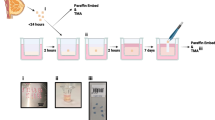Summary
Estrogen receptor (ER) and total binding capacity for cyclic AMP (cAR) were measured in cytosols from human mammary tumors. Patients with advanced, evaluable breast cancer were biopsied before the start of endocrine treatment, and ER and cAR measurements were performed. All patients included in this study were ER positive.
Sixteen of 30 patients (53%) had an objective response to endocrine treatment. When ER and cAR were expressed as a ratio and this ratio was related to treatment response, it was found that all objective responders had ratio values above 2.5 × 10−3. Nine of 14 nonresponders had ER/cAR ratios below this value. In our limited series of patients a threshold limit of 2.5 × 10−3 would have correctly predicted the response to endocrine treatment in 25 of 30 patients (83%). In patients with ER values below 100 fmol/mg protein and PgR negative or unknown, cAR might strengthen the predictive value of steroid receptor measurements.
Similar content being viewed by others
References
Jensen EV, DeSombre ER, Jungblut PW: Estrogen receptors in hormone-responsive tissues and tumors.In RW Wissler, TL Dao, S Wood Jr (eds). Endogenous Factors Influencing Host—Tumor Balance. University of Chicago Press, Chicago, 1967, pp 15–30.
McGuire WL, Carbone PP, Vollmer EP: Estrogen Receptors in Human Breast Cancer. Raven Press, New York, 1975
McGuire WL: An update on estrogen and progesterone receptors in prognosis for primary and advanced breast cancer.In S. Iacobelli, RJB King, HR Lindner, ME Lippman (eds). Hormones and Cancer. Progress in Cancer Research and Therapy, Vol 14. Raven Press, New York, 1980, pp 337–343
Huggins C, Briziarelli G, Sutton H Jr: Rapid induction of mammary carcinoma in the rat and the influence of hormones on the tumors. J Exp Med 109:25–42, 1959
Bodwin JS, Cho-Chung YS: Inverse relation between estrogen receptors and cyclic adenosine 3′:5′-monophosphatebinding proteins in hormone-dependent mammary tumor regression due to dibutyryl cyclic adenosine 3′:5′-monophosphate treatment or ovariectomy. Cancer Res 38:3410–3413, 1978
Cho-Chung YS: On the mechanism of cyclic AMP-mediated growth arrest of solid tumors. Adv Cyclic Nucleotide Res 12:111–121, 1980
Cho-Chung YS, Bodwin JS, Clair T: Cyclic AMP binding proteins. Inverse relationship with estrogen receptors in hormone dependent tumor regression. Eur J Biochem 86:51–60, 1978
Bodwin JS, Clair T, Cho-Chung YS: Relationship of hormone dependency to estrogen receptor and adenosine 3′,5′-cyclic monophosphate-binding proteins in rat mammary tumors. J Natl Cancer Inst 64:395–398, 1980
Hayward JL, Rubens RD, Carbone PP, Heuson J-C, Kumaoka S, Segaloff A: Assessment of response to therapy in advanced breast cancer. Br J Cancer 35:292–298, 1977
Thorsen T: Occupied and unoccupied nuclear oestradiol receptor in human breast tumours: Relation to oestradiol and progesterone cytosol receptors. J Steroid Biochem 10:661–668, 1979
Døskeland SO, Haga HJ: Measurement of adenosine 3′:5′-cyclic monophosphate by competitive binding to salt-dissociated protein kinase. Biochem J 174:363–372, 1978
Døskeland SO, Ueland PM, Haga HJ: Factors affecting the binding of3H-adenosine 3′:5′-cyclic monophosphate to protein kinase from bovine adrenal cortex. Biochem J 161:653–665, 1977
Døskeland SO, Øgreid D: Binding proteins for cyclic AMP in mammalian tissues. Int J Biochem 13:1–19, 1981
Øgreid D, Døskeland SO: Protein kinase II has two distinct binding sites for cyclic AMP, only one of which is detectable by the conventional membrane-filtration method. FEBS Lett 121:340–344
King RBJ, Hayward JL, Masters JRW, Millis RR, Rubens RD: Steroid receptor assays as prognostic aids in the treatment of breast cancer.In JL Witliff, O Dapunt (eds). Steroid Receptors and Hormone-dependent Neoplasia. Masson Publishing USA, New York, 1980
Corbin JD, Keely SL, Park CR: The distribution and dissociation of cyclic adenosine 3′,5′-monophosphate dependent protein kinases in adipose, cardiac and other tissues. J Biol Chem 250:218–225, 1975
Cho-Chung YS, Archibald D, Clair T: Cyclic AMP receptor triggers nuclear protein phosphorylation in a hormonedependent mammary tumor cell-free system. Science 205:1390–1392, 1979
Cho-Chung YS, Clair T, Bodwin JS, Berghoffer B: Growth arrest and morphological change of human breast cancer cells by dibutyryl cyclic AMP and L-arginine. Science 214:77–79, 1981
Author information
Authors and Affiliations
Rights and permissions
About this article
Cite this article
Kvinnsland, S., Ekanger, R., Døskeland, S.O. et al. Relationship of cyclic AMP binding capacity and estrogen receptor to hormone sensitivity in human breast cancer. Breast Cancer Res Tr 3, 67–72 (1983). https://doi.org/10.1007/BF01806235
Issue Date:
DOI: https://doi.org/10.1007/BF01806235




